This article appeared originally in the French publication PERCUSSIONS: Cahier Bimensiel d’Etudes et d’Informations sur les Arts de la Percussion. March /April 1993. Its original title was “Mrdangam et Tabla: un Contraste”.
Introduction
Tabla and mridangam form the basis for the classical percussion in India. Questions arise as to the differences and similarities between the two. This article will concentrate upon the differences. These differences may fall into four categories; construction, tone, technique, and philosophy.
Background
The music of India is one of the oldest systems of music in the world. Today there are two branches. There is the Hindustani sangeet of the North and the Carnatic sangeet in the south. Collectively these two limbs form the body of a musical tradition that is said to extend back several thousand years. Although there are many similarities between the two systems there are also differences. One of the differences is in the choice of rhythmic accompaniment.
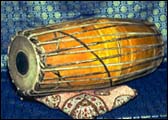 | 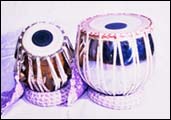 |
| 1a. Mridangam | 1b. Tabla |
The Carnatic sangeet of southern India prefers a drum called mridangam. This instrument is a single piece of wood that is hollowed out and has playing heads on both sides (Fig. 1a, above). The mridangam is a south Indian representative of a class of instrument known as mridang. This class includes other drums like maddal, shuddha maddalam, kol, and pakhawaj (Courtney&Courtney 1992).
North Indian music (Hindustani sangeet) prefers the tabla (Fig. 1b, above). This is a small wooden drum call danya and a larger metal one called banya. It is said that tabla was developed by cutting a pakhawaj (a mridang) into two pieces (Courtney 1980).
Construction
There are a number of differences between the construction of mridangam and tabla. Some of the differences are obvious and some are more subtle.
The most obvious difference in construction is that mridangam uses a single shell while the tabla uses two. Therefore the tension of the left and right sides of tabla are separately controlled, while they are inseparably linked in mridangam. Mridangam‘s single shell also produces an acoustic coupling between the two heads (Bhat 1991).
The drumheads show major differences. For instance the mridangam is made of extremely heavy hides while the tabla uses thinner ones. The left hand tabla has a permanent dry application while the mridangam has a temporary wet application of flour and water. Both drums have a skin that does not completely cover the surface (Courtney 1988). There is a hole in this outer covering which exposes the main membrane below. This annular membrane is much more prominent in the mridangam than in the tabla.
There are items placed between the main membrane and the annular membrane that further accentuate these differences. Tabla often has a string placed between the annular covering and the main skin, while mridangam has straw. This may not appear to be a significant difference but the purpose of these insertions is diametrically opposite. String is placed in the tabla to lift the annular membrane and reduce the dampening effect. However the mridangam has pieces of straw placed radially between the two skins. This actually increases the dampening and acts as a snare. The cumulative effects of these differences in construction create major differences in the tone of the instrument (Rossing 1992).
Tone
Both tabla and mridangam are characterized by a rich and varied tone. Some strokes evoke clear pitched sounds while others evoke unpitched sounds. We will concentrate our discussion upon the pitched strokes because they more clearly show the tonal differences (Courtney 1991).
Rim Stroke (right hand) – The rim stroke is a major stroke on both the tabla and the mridangam. Although the nomenclature varies this stroke is usually called “Naa” in the North and “Nam” in the South. On both instruments a predominant third harmonic is the main characteristic (Fig. 2 a,b; below). However, the fundamental may be seen in significant proportion in the mridang while it is essentially absent in the tabla. Furthermore the second harmonic tends to be evoked in the tabla while it is suppressed in the mridangam.

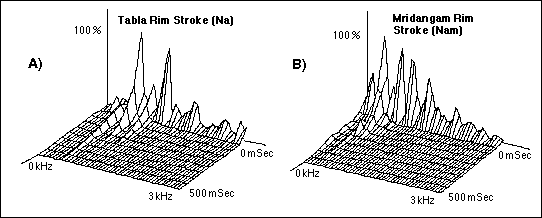
Open stroke (right hand) – The open stroke is also a major stroke for both drums. This is called “Tun” in the North and “Deem” in the South. Both strokes are characterized by a very prominent fundamental. However there is a significant difference in the second harmonic (Fig. 2 c,d).
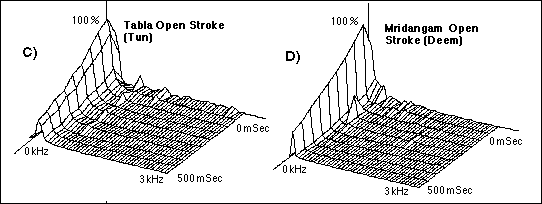
Open stroke (left hand) – The open stroke of the left hand is called “Ga” in the North and “Thom” in the South. It shows a tremendous difference between the two instruments (fig. 2 e,f). We find that the tabla has a very pronounced fundamental and a long sustain. There are much fewer harmonics in this stroke. Conversely the mridangam has a much more complex harmonic spectrum and a significantly reduced sustain.
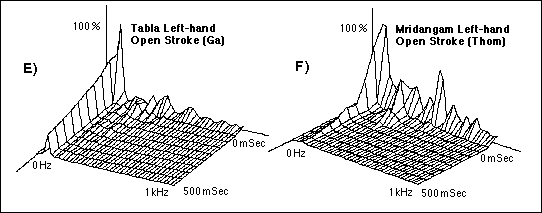
Technique
The fingering technique is a very important consideration in our discussion. Tabla has a distinct leaning toward the delicate fingering while the mridangam has a balance between the powerful and delicate techniques. A brief look at the history of the instruments shows why.
The evolution of both the tabla and mridangam may be traced to an archetypical mridang. This instrument had a close association to the ancient mythological dramas. This association meant that the drums would sometimes have to support both masculine and feminine characters. The delicate movements of the dance are known as lasya while the more powerful masculine movements are known as tandava. Powerful techniques were developed to accentuate the masculine roles while delicate techniques were developed to support the feminine roles.
In the last several centuries the drumming technique in north Indian music has bifurcated. The more powerful and aggressive techniques have been relegated to the pakhawaj while the delicate techniques have been relegated to tabla.
Yet there was no bifurcation of technique in the South. The powerful and aggressive techniques exist alongside the delicate.
Philosophy
There is another area of difference between the tabla and the mridangam. This reflects a basic philosophic difference between North and South Indian music.
The tabla provides the rhythmic base for the entire performance. Since the main performer will constantly refer to the tabla, it is essential that there be a conventionally established pattern that may be universally understood. This pattern is called theka. Too much variation from the established theka may lead to a breakdown in communication and thus compromise the entire performance. In the old days, vocalists and instrumentalists would not allow their tabla players to play anything except theka. Today there is much greater freedom, still the basic responsibility remains.
The role of the mridangam is much different. The mridangam does not have to provide the rhythmic base for the performance. Such a base is provided by a conventionally established pattern of claps and waves. Half of the audience in a south Indian performance may be clapping along with the performers. With so many people providing the base there is a greater freedom given to the mridangam player. The consequence of not having to provide a base means that there is no such thing as a theka, therefore different accompanying rhythms may be used according to the artistic discretion of the performers.
Conclusion
The tabla and the mridangam form the basis for the rhythmic accompaniment of classical Indian music. The tabla has dominion in the north, while mridangam is used in the south. Both have a common ancestry in an archetypical mridang whose technique could be either powerful or delicate. Such technique is found today in the mridangam while the tabla is the recipient of the more delicate techniques.
There is a major difference in the tone of the instruments. This is due primarily from differences in construction. Although there are obvious differences in the resonators the greatest tonal difference is derived from construction of the heads.
Regardless of the differences, these drums may be seen as the two legs upon which the classical music of India is based. Both legs are firm and steady to carry this ancient system forward into the next millennium.
Works Cited
Bhat, R.B.
1991 “Acoustics of a Cavity-Backed Membrane: The Indian Musical Drum”. Journal of the Society of America. Vol. 90, No 3: 1469-1474
Courtney, David and C. N. Courtney
1992 Elementary North Indian Vocal. Houston: Sur Sangeet Services.
Courtney, David
1980 Introduction to Tabla. Hyderabad: Anand Power Press.
1988 “The Tabla Puddi”, Experimental Musical Instruments. Nicasio, CA: Vol. 4, No 4, Dec 1988: 12-16.
1991 “Tuning the Tabla: A Psychoacoustic Perspective”, Percussive Notes, Percussive Arts Society, Urbana Il: Vol 29, No 3, Feb 1991: 59-61
Rossing, Thomas D.
1992 “Acoustics of Drums”. Physics Today. New York, American Institute of Physics. March 1992, Vol 45, No 3: 40-47